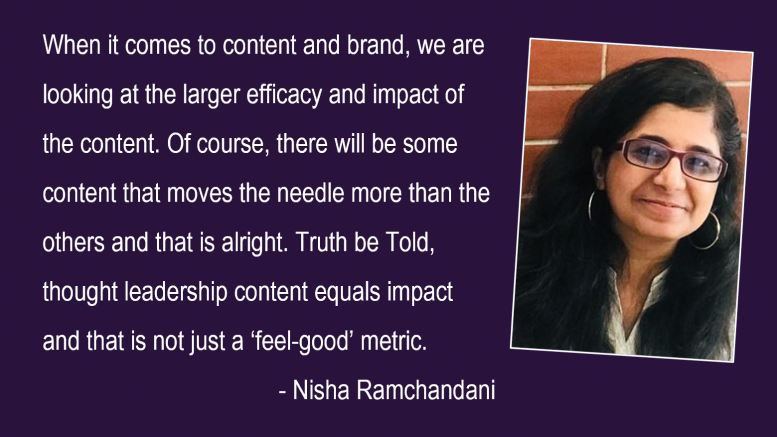I ended my previous piece on the point of distribution. This one will start there too.
Indians spend 4.9 hours a day on their phones. The kind of content that Indians consume on social media centers around – productivity, tools, health, lifestyle, shopping etc.
You can look at this statistic two ways. 1) There is immense potential for any new kind of content 2) Content you put out, really has to strike a chord for it to be consumed. Or simply put, there is a lot of noise out there. It is perhaps one reason why many startups today have adopted the easy way out and bought relevant media businesses for distribution. Take the example of Nykaa acquiring the Little Black Book or Hubspot acquiring The Hustle. I am sure their reasons are beyond distribution and more strategy; though, it drives home the point that credible content that does not reek of marketing is here to stay. We have heard of the fact that every company is a media company, but the truth is every company is a media distributor first. If you get the distribution game right, that is.
So, how should one think of a brand’s content strategy?
I call it a spectrum and each brand will have its own. Generally, this spectrum will contain three pillars – SEO, Lead-Gen and Thought Leadership content. Each of them require a specific content strategy and are all also measured differently. In this piece we are talking about thought-leadership content only. Gone are the days when the media (only) was leveraged for thought leadership content. In an (email) interview for this piece, Senjam Raj Sekhar, the OG of thought leadership content and the brain behind Flipkart Stories said, ‘All brands can and should create a media property or a storytelling platform, because every company has hundreds of stories of their people, customers and their business. However, creating a platform requires time, resources and long term commitment.” In addition to that, it also requires a clear strategy – one such example is shared by Senjam – ‘At Flipkart Stories, we did several long form stories. Like how Naxalbari, a village that gave its name to the Naxalite movement is now embracing e-commerce with gusto or how Pokhran, the site of India’s first nuclear test is now a thriving e-commerce center; the inspirations came from long form magazines like The Atlantic or The New Yorker.’
So, you see, this content is educative, informative and/ or occupies a space of emotions. Truth be Told is a newsletter by The Whole Truth Food born of the need to get health journalism right. Anoo Bhuyan, head of Media Labs at The Whole Truth Foods said, ‘when it comes to content and brand, we are looking at the larger efficacy and impact of the content. Of course, there will be some content that moves the needle more than the others and that is alright.’ Truth be Told (pun intended), thought leadership content equals impact and that is not just a ‘feel-good’ metric.
How does one measure Impact?
In Senjam’s words, ‘The good part of digital is that it is highly measurable. We measured Flipkart Stories on three parameters. We had goals for website readership – traffic, time spent, bounce rate and reader engagement. During the time that I was there, we averaged around half a million views per month.
Secondly, we created social handles on Twitter, Facebook & Instagram. Here we measured our follower count, engagement as well as traffic referrals to Flipkart Stories site.
The third parameter we measured was our domination of search. Let me give you an example of search. When unscrupulous elements started running fraud campaigns using Flipkart’s name, we came up with stories on how to differentiate fake or fraud products from real ones.’
Humanise, by Plum (an insurtech company), covers the intersection of work and life. It was started to talk to the employee/ beneficiary by the B2B brand (disclaimer: I am the Editor). Impact, here, is measured through page views and shares. The idea is about curation and getting as many people to write about how they experience work. This in turn, helps build empathy for Plum and also creates brand awareness.
Similarly, content helps brands acquire discerning customers and also retain existing ones. Says Abhimanyu Ghoshal, Content Lead at Hashnode, ‘in the digital-era, content is how brands can differentiate themselves from their competitors. Customers, new or old, are always looking for that extra- and content can truly help a brand in establishing trust.’ According to Abhimanyu metrics like viewership, bounce rates, engagement are all equally important as the intangibles as they shine a light on how to go about the next big milestone. For example: If an accessories brand publishes content around developing design sensibility and its thoughtful approach to sourcing materials sustainably, that goes a long way in customers deeply connecting with the brand and sticking with them.
That is important, as all of us agree that creating a media-property might be easier than sustaining one.
Ensure your content creates ‘return value’.
Ambi Parameswaran is an independent brand strategist with over 40 years’ experience in brand strategy and advertising. Ask him about content as a strategy and he will tell you that content as a funnel will work only if it has retention value or if you can include a ‘response device’. He says in the earlier days it used to be coupons, however, today you can call it a CTA (Call to Action). In the case of thought leadership, that CTA is returning viewers/ readers. As the content property scales, it will be important to measure who is coming back and why. Also, do they have enough incentive to come back?
Many people today keep talking about ChatGPT being the nemesis of the content writer, however, the truth is that it can only enhance their lives (if used well). A lot about scale will depend on how content and tools are married. Using Midjourney, ChatGPT or AI video tools will only make scaling an easier and more cost-effective journey and the faster we learn to use them, the better will be our output. To sum up, while it is important to use content as a moat, it is equally important to measure that journey and while doing so, remember tools are your allies. Once you start, this is a continuous journey and as you build distribution, keep asking yourself – ‘is my audience coming back or is it all happening inside my head?’
The views and opinions published here belong to the author and do not necessarily reflect the views and opinions of the publisher.



Be the first to comment on "Is Content Measurable or Just Feel-Good for Brands?"